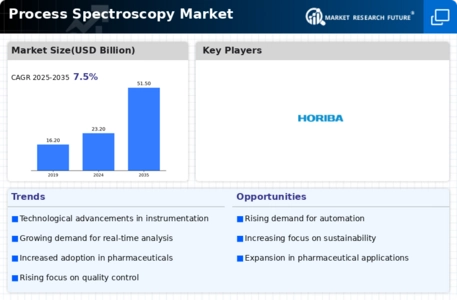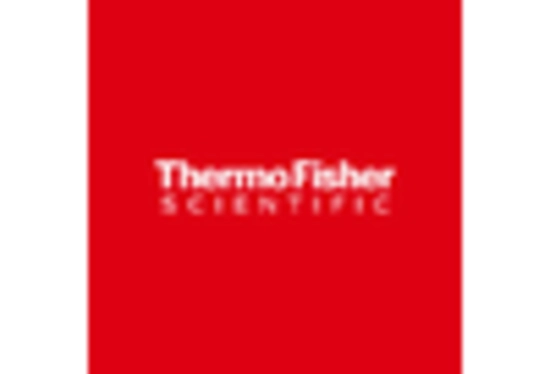-
EXECUTIVE SUMMARY
-
MARKET INTRODUCTION
-
Definition
-
Scope of the Study
- Research Objective
- Assumptions
- Limitations
-
RESEARCH METHODOLOGY
-
Overview
-
Data Mining
-
Secondary Research
-
Primary Research
- Primary Interviews and Information Gathering Process
- Breakdown of Primary Respondents
-
Forecasting Model
-
Market Size Estimation
- Bottom-Up Approach
- Top-Down Approach
-
Data Triangulation
-
Validation
-
MARKET DYNAMICS
-
Overview
-
Drivers
-
Restraints
-
Opportunities
-
MARKET FACTOR ANALYSIS
-
Value Chain Analysis
-
Porter’s Five Forces Analysis
- Bargaining Power of Suppliers
- Bargaining Power of Buyers
- Threat of New Entrants
- Threat of Substitutes
- Intensity of Rivalry
-
COVID-19 Impact Analysis
- Market Impact Analysis
- Regional Impact
- Opportunity and Threat Analysis
-
GLOBAL PROCESS SPECTROSCOPY MARKET, BY TECHNOLOGY
-
Overview
-
NIR
-
FT-IR
-
Raman
-
GLOBAL PROCESS SPECTROSCOPY MARKET, BY END USE
-
Overview
-
Oil and Gas
-
Pharmaceuticals
-
Food and Agriculture
-
Chemical
-
Others
-
GLOBAL PROCESS SPECTROSCOPY MARKET, BY REGION
-
Overview
-
North America
- US
- Canada
-
Europe
- Germany
- France
- UK
- Italy
- Spain
- Rest of Europe
-
Asia-Pacific
- China
- India
- Japan
- South Korea
- Australia
- Rest of Asia-Pacific
-
Rest of the World
- Middle East
- Africa
- Latin America
-
COMPETITIVE LANDSCAPE
-
Overview
-
Competitive Analysis
-
Market Share Analysis
-
Major Growth Strategy in the Global Process Spectroscopy Market,
-
Competitive Benchmarking
-
Leading Players in Terms of Number of Developments in the Global Process Spectroscopy Market,
-
Key developments and Growth Strategies
- New End use Launch/Service Deployment
- Merger & Acquisitions
- Joint Ventures
-
Major Players Financial Matrix
- Sales & Operating Income, 2024
- Major Players R&D Expenditure. 2024
-
COMPANY PROFILES
-
ABB Ltd.
- Company Overview
- Financial Overview
- End uses Offered
- Key Developments
- SWOT Analysis
- Key Strategies
-
Shimadzu Corporation
- Company Overview
- Financial Overview
- End uses Offered
- Key Developments
- SWOT Analysis
- Key Strategies
-
AGILENT TECHNOLOGIES, INC
- Company Overview
- Financial Overview
- End uses Offered
- Key Developments
- SWOT Analysis
- Key Strategies
-
Sartorius AG
- Company Overview
- Financial Overview
- End uses Offered
- Key Developments
- SWOT Analysis
- Key Strategies
-
Bruker Corporation
- Company Overview
- Financial Overview
- End uses Offered
- Key Developments
- SWOT Analysis
- Key Strategies
-
Kett Electric Laboratory
- Company Overview
- Financial Overview
- End uses Offered
- Key Developments
- SWOT Analysis
- Key Strategies
-
Buchi Labortechnik AG.
- Company Overview
- Financial Overview
- End uses Offered
- Key Developments
- SWOT Analysis
- Key Strategies
-
HORIBA LIMITED
- Company Overview
- Financial Overview
- End uses Offered
- Key Developments
- SWOT Analysis
- Key Strategies
-
Danaher Corporation
- Company Overview
- Financial Overview
- End uses Offered
- Key Developments
- SWOT Analysis
- Key Strategies
-
Foss A/S
- Company Overview
- Financial Overview
- End uses Offered
- Key Developments
- SWOT Analysis
- Key Strategies
-
APPENDIX
-
References
-
Related Reports
-
-
LIST OF TABLES
-
GLOBAL PROCESS SPECTROSCOPY MARKET, SYNOPSIS, 2018-2032
-
GLOBAL PROCESS SPECTROSCOPY MARKET, ESTIMATES & FORECAST, 2020-2034(USD BILLION)
-
GLOBAL PROCESS SPECTROSCOPY MARKET, BY TECHNOLOGY, 2020-2034(USD BILLION)
-
GLOBAL PROCESS SPECTROSCOPY MARKET, BY END USE, 2020-2034(USD BILLION)
-
NORTH AMERICA: PROCESS SPECTROSCOPY MARKET, BY TECHNOLOGY, 2020-2034(USD BILLION)
-
NORTH AMERICA: PROCESS SPECTROSCOPY MARKET, BY END USE, 2020-2034(USD BILLION)
-
US: PROCESS SPECTROSCOPY MARKET, BY TECHNOLOGY, 2020-2034(USD BILLION)
-
US: PROCESS SPECTROSCOPY MARKET, BY END USE, 2020-2034(USD BILLION)
-
CANADA: PROCESS SPECTROSCOPY MARKET, BY TECHNOLOGY, 2020-2034(USD BILLION)
-
CANADA: PROCESS SPECTROSCOPY MARKET, BY END USE, 2020-2034(USD BILLION)
-
EUROPE: PROCESS SPECTROSCOPY MARKET, BY TECHNOLOGY, 2020-2034(USD BILLION)
-
EUROPE: PROCESS SPECTROSCOPY MARKET, BY END USE, 2020-2034(USD BILLION)
-
GERMANY: PROCESS SPECTROSCOPY MARKET, BY TECHNOLOGY, 2020-2034(USD BILLION)
-
GERMANY: PROCESS SPECTROSCOPY MARKET, BY END USE, 2020-2034(USD BILLION)
-
FRANCE: PROCESS SPECTROSCOPY MARKET, BY TECHNOLOGY, 2020-2034(USD BILLION)
-
FRANCE: PROCESS SPECTROSCOPY MARKET, BY END USE, 2020-2034(USD BILLION)
-
ITALY: PROCESS SPECTROSCOPY MARKET, BY TECHNOLOGY, 2020-2034(USD BILLION)
-
ITALY: PROCESS SPECTROSCOPY MARKET, BY END USE, 2020-2034(USD BILLION)
-
SPAIN: PROCESS SPECTROSCOPY MARKET, BY TECHNOLOGY, 2020-2034(USD BILLION)
-
SPAIN: PROCESS SPECTROSCOPY MARKET, BY END USE, 2020-2034(USD BILLION)
-
UK: PROCESS SPECTROSCOPY MARKET, BY TECHNOLOGY, 2020-2034(USD BILLION)
-
UK: PROCESS SPECTROSCOPY MARKET, BY END USE, 2020-2034(USD BILLION)
-
REST OF EUROPE: PROCESS SPECTROSCOPY MARKET, BY TECHNOLOGY, 2020-2034(USD BILLION)
-
REST OF EUROPE: PROCESS SPECTROSCOPY MARKET, BY END USE, 2020-2034(USD BILLION)
-
ASIA-PACIFIC: PROCESS SPECTROSCOPY MARKET, BY TECHNOLOGY, 2020-2034(USD BILLION)
-
ASIA-PACIFIC: PROCESS SPECTROSCOPY MARKET, BY END USE, 2020-2034(USD BILLION)
-
JAPAN: PROCESS SPECTROSCOPY MARKET, BY TECHNOLOGY, 2020-2034(USD BILLION)
-
JAPAN: PROCESS SPECTROSCOPY MARKET, BY END USE, 2020-2034(USD BILLION)
-
CHINA: PROCESS SPECTROSCOPY MARKET, BY TECHNOLOGY, 2020-2034(USD BILLION)
-
CHINA: PROCESS SPECTROSCOPY MARKET, BY END USE, 2020-2034(USD BILLION)
-
INDIA: PROCESS SPECTROSCOPY MARKET, BY TECHNOLOGY, 2020-2034(USD BILLION)
-
INDIA: PROCESS SPECTROSCOPY MARKET, BY END USE, 2020-2034(USD BILLION)
-
AUSTRALIA: PROCESS SPECTROSCOPY MARKET, BY TECHNOLOGY, 2020-2034(USD BILLION)
-
AUSTRALIA: PROCESS SPECTROSCOPY MARKET, BY END USE, 2020-2034(USD BILLION)
-
SOUTH KOREA: PROCESS SPECTROSCOPY MARKET, BY TECHNOLOGY, 2020-2034(USD BILLION)
-
SOUTH KOREA: PROCESS SPECTROSCOPY MARKET, BY END USE, 2020-2034(USD BILLION)
-
REST OF ASIA-PACIFIC: PROCESS SPECTROSCOPY MARKET, BY TECHNOLOGY, 2020-2034(USD BILLION)
-
REST OF ASIA-PACIFIC: PROCESS SPECTROSCOPY MARKET, BY END USE, 2020-2034(USD BILLION)
-
REST OF THE WORLD: PROCESS SPECTROSCOPY MARKET, BY TECHNOLOGY, 2020-2034(USD BILLION)
-
REST OF THE WORLD: PROCESS SPECTROSCOPY MARKET, BY END USE, 2020-2034(USD BILLION)
-
MIDDLE EAST: PROCESS SPECTROSCOPY MARKET, BY TECHNOLOGY, 2020-2034(USD BILLION)
-
MIDDLE EAST: PROCESS SPECTROSCOPY MARKET, BY END USE, 2020-2034(USD BILLION)
-
AFRICA: PROCESS SPECTROSCOPY MARKET, BY TECHNOLOGY, 2020-2034(USD BILLION)
-
AFRICA: PROCESS SPECTROSCOPY MARKET, BY END USE, 2020-2034(USD BILLION)
-
LATIN AMERICA: PROCESS SPECTROSCOPY MARKET, BY TECHNOLOGY, 2020-2034(USD BILLION)
-
LATIN AMERICA: PROCESS SPECTROSCOPY MARKET, BY END USE, 2020-2034(USD BILLION)
-
LIST OF FIGURES
-
RESEARCH PROCESS
-
MARKET STRUCTURE FOR THE GLOBAL PROCESS SPECTROSCOPY MARKET
-
MARKET DYNAMICS FOR THE GLOBAL PROCESS SPECTROSCOPY MARKET
-
GLOBAL PROCESS SPECTROSCOPY MARKET, SHARE (%), BY TECHNOLOGY, 2024
-
GLOBAL PROCESS SPECTROSCOPY MARKET, SHARE (%), BY END USE, 2024
-
GLOBAL PROCESS SPECTROSCOPY MARKET, SHARE (%), BY REGION, 2024
-
NORTH AMERICA: PROCESS SPECTROSCOPY MARKET, SHARE (%), BY REGION, 2024
-
EUROPE: PROCESS SPECTROSCOPY MARKET, SHARE (%), BY REGION, 2024
-
ASIA-PACIFIC: PROCESS SPECTROSCOPY MARKET, SHARE (%), BY REGION, 2024
-
REST OF THE WORLD: PROCESS SPECTROSCOPY MARKET, SHARE (%), BY REGION, 2024
-
GLOBAL PROCESS SPECTROSCOPY MARKET: COMPANY SHARE ANALYSIS, 2024 (%)
-
ABB LTD.: FINANCIAL OVERVIEW SNAPSHOT
-
ABB LTD.: SWOT ANALYSIS
-
SHIMADZU CORPORATION: FINANCIAL OVERVIEW SNAPSHOT
-
SHIMADZU CORPORATION: SWOT ANALYSIS
-
AGILENT TECHNOLOGIES, INC: FINANCIAL OVERVIEW SNAPSHOT
-
AGILENT TECHNOLOGIES, INC: SWOT ANALYSIS
-
SARTORIUS AG: FINANCIAL OVERVIEW SNAPSHOT
-
SARTORIUS AG: SWOT ANALYSIS
-
BRUKER CORPORATION.: FINANCIAL OVERVIEW SNAPSHOT
-
BRUKER CORPORATION.: SWOT ANALYSIS
-
KETT ELECTRIC LABORATORY: FINANCIAL OVERVIEW SNAPSHOT
-
KETT ELECTRIC LABORATORY: SWOT ANALYSIS
-
BUCHI LABORTECHNIK AG.: FINANCIAL OVERVIEW SNAPSHOT
-
BUCHI LABORTECHNIK AG.: SWOT ANALYSIS
-
HORIBA LIMITED: FINANCIAL OVERVIEW SNAPSHOT
-
HORIBA LIMITED: SWOT ANALYSIS
-
DANAHER CORPORATION: FINANCIAL OVERVIEW SNAPSHOT
-
DANAHER CORPORATION: SWOT ANALYSIS
-
FOSS A/S: FINANCIAL OVERVIEW SNAPSHOT
-
FOSS A/S: SWOT ANALYSIS








Leave a Comment